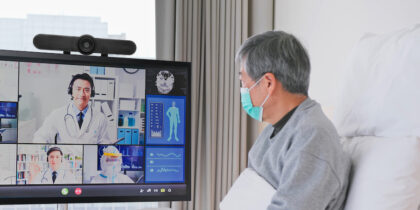Few would argue that satisfaction with the current state of healthcare is at an all-time low among physicians, nurses and patients. Frustrations arising from limited face-to-face time, the pressures put on providers by regulators and payers, and a lack of access to affordable care are driving interest in telehealth from both the patient and physician perspective. Telehealth (or telemedicine), as defined by the American Telemedicine Association (ATA), is: “… the use of medical information exchanged from one site to another via electronic communications to improve a patient’s clinical health status.”
Growing Demand
Right now, there are physician shortages in primary care as well as in many specialties (dermatology, mental health and neurology). Telemedicine can fill care gaps and create points of care at home. There is a movement toward the consumerization of healthcare because of the predominance of high-deductible and copay policies offered in payer arenas. This translates to people seeking alternative care pathways, and the low fee for telehealth through videoconferencing is emerging as a dominant force. The convenience factor of service companies like Uber and Airbnb is now being sought after in healthcare.
According to a recent Towers Watson survey, 34 percent of employers are considering offering their employees telemedicine consultation services in 2016 or 2017 for non-emergency care. However, the employer survey reveals the disappointing statistic that at companies that offer this service, less than 10 percent of employees utilize it. A lack of awareness and education about the benefits and services may contribute to this number.
Of equal importance are the findings from a public survey by Software Advice: Among patients who have not used a telemedicine service, 75 percent express interest in using one in lieu of an in-person medical visit, and only 16 percent of patients would prefer to seek care for a minor ailment at an emergency room (ER) if they also had access to telehealth services.
Despite these findings, barriers to telemedicine adoption exist. There are issues regarding reimbursement by insurers; according to a 2015 report by the ATA, coverage for telemedicine is inconsistent, with varying degrees of services covered. The question of licensure for healthcare providers of telemedicine is another large and looming issue. The Federation of State Medical Boards is addressing this in a Compact among states, which may ultimately result in a national license for telemedicine providers.
Improving the Patient/Physician Interaction
Telemedicine has implications even beyond healthcare. It will herald the delivery of mobile health, and visits will incorporate data derived from technologies using the latest Samsung biosensors. Visits can also be mobile, via quality devices like the Galaxy tablets. Telemedicine might result in new types of physicians who thrive in a digital environment that incorporates various technologies in each virtual visit. The use of this technology offers convenience along with privacy in a setting such as an unmanned kiosk, as designed by MEDEX SPOT, at work or in another public place. More importantly, what’s missing most in the traditional in-person, 20-minute visit, ironically, is the personal interaction. This is often lost due to time pressure and the presence of the EHR computer screen, which can become the healthcare provider’s primary focus.
Moving forward, telemedicine will improve the way we follow patients with chronic diseases. This population accounts for the majority of healthcare dollars spent and overall healthcare resource utilization. Providing digital means to interact with and engage these patients and caregivers offers an opportunity to detect problems before they become crises that result in morbidity, mortality or acute care visits. As the industry matures, more companies will enter this space, offering more diversified and comprehensive services. Telemedicine will change the landscape of healthcare as it helps fill the physician care gap and provide patients and physicians with the tools for more personal interactions.
Learn more about the technology solutions that can support an effective telehealth strategy.







